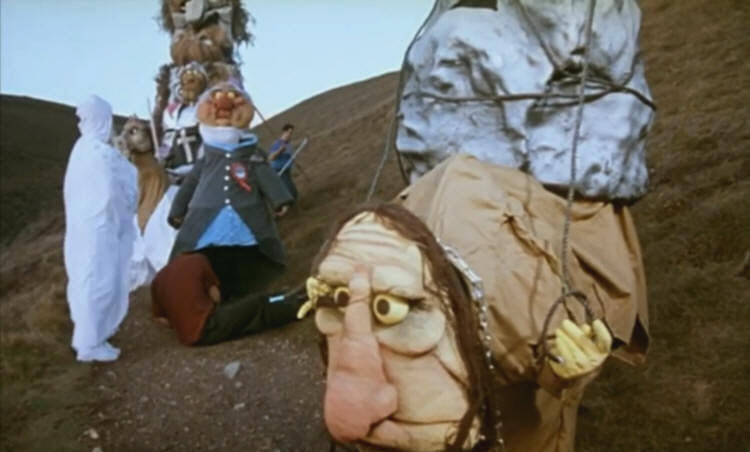|
Is Andrew Kötting's
‘Gallivant’ folk horror?
Rupert White
Andrew Kötting’s ‘Gallivant’ (1996) has been compared to Derek Jarman’s
early experimental films, such as ‘The Last of England’ (1987).
Certainly both Kötting and Jarman used non-synchronous sound, a mix of
film stocks and film speeds, found-footage and improvised sequences to
create a free-form cinema which bucks convention, and tends towards the
dreamy and impressionistic. But as the title suggests (to ‘Gallivant’ is
to travel in search of pleasure and fun) Gallivant is more playful and
light-hearted than any of Jarman’s work and has a strong streak of
anarchy running through it.
Kötting, with his 7 year old daughter and 85 year old grandmother, goes
on a tour of Britain’s coast, starting at Bexhill-on-Sea in Sussex,
travelling clockwise. As his merry crew visit Britain’s down-at-heel
seaside resorts Kötting himself goes swimming fully clothed on more than
one occasion, and is filmed clinging on to the outside of the camper van
as the others travel inside it.

But it’s his daughter, Eden,
who has Joubert’s syndrome and his grandmother Gladys who are the real
stars of the show. We typically see them sitting together, talking to
the camera, Eden using sign language. They have a very natural bond, and
at one point Kötting asks them to lick some postage stamps. Gladys and
then Eden oblige, unhurriedly, and we see each of their wet pink tongues
in startling close-up. The moment is strangely poignant, and typical of
the intimacy and tenderness with which the film was made.
It is therefore a heart-warming tale, but is ‘Gallivant’ Folk Horror?
No, not really, but it certainly touches on issues of mortality. Kötting
is also careful to include a good smattering of folklore, such that the
people in the film appear fully embedded in their landscapes and their
history, whether they are singers in Carlisle, accordion players in
Grimsby, visitors to the Munlochy Clootywell in Scotland, Sword Dancers
in Yorkshire, Jack-in-the-Green celebrants in Hastings, or Giant Bolster
performers in St Agnes.
In St Agnes, in fact, the players in question re-enact the annual
Bolster pageant especially for Kötting and his crew on the cliffs at
Chapelporth. (The Jack in the Green is also a re-enactment). The
narrator is a local man who retells the story of Bolster; the giant who
bleeds to death trying to prove his love for the young Agnes. Normally
the pageant would be performed to an audience, but as there is none it
becomes easier for Kötting’s camera to come much closer to the action
than would otherwise be possible. There is warm sunlight, and the huge
towering puppets, which in 1996 were in fact only a few years old, look
primeval and otherworldly. In fact, with elemental waves crashing below,
this is undoubtedly the most ‘Wicker Man’ - the most Folk Horror -
moment in his film.

In Cornwall Kötting and his
crew also visit Lizard Point, Goonhilly Earth Station, and Newquay. In
Newquay they film a ladies’ bowls match, the players all wearing
pristine white coats and straw hats. Chűn Quoit, in contrast, is filmed
against the sunset, with a narration about Arthur and his Knight
returning to rescue Britain.
Kötting also comments: The
travelling was working well as a mental distraction and a means of
understanding, and by the time we passed Land’s End I was struck by an
incredible sense of loss and yearning. But in a way that undercuts
any seriousness, as he does so, the sound man is filmed recording the
silent stone monument.
Gallivant is
currently available to stream on the BFI player
29.1.23 |


